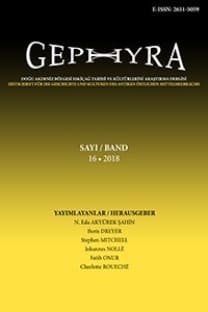Nagidos Arkaik, Klasik ve Hellenistik Dönem Mutfak ve Pişirim Kapları
Nagidos, Mutfak ve Pişirim Kabı, Arkaik Donem, Klasik Donem, Hellenistik Donem, Mortar, Chytra, Lopas, Tagenon
Archaic, Classical and Hellenistic Kitchen and Cooking Wares from Nagidos
Nagidos, kitchen and cooking ware, Archaic Period, Classical Period, Hellenistic Period, Mortar, Chytra, Lopas, Tagenon,
___
- B. Adamsheck, Kenchreai eastern port of Corinth, IV. The pottery, Leiden 1979.
- V. R. Anderson-Stajanović, Stobi. The Hellenistic and Roman pottery, Princeton 1992.
- A. M. Berlin, The Plain Wares, şurada: S. C. Herbert (ed.), Tel Anafa II. i: The Hellenistic and Roman pottery, Ann Arbor 1997, 1-211, Pl. 1-94.
- A. M. Berlin, Studies in Hellenistic Ilion: The Lower City. Stratified Assemblages and Chronology, Studia Troica 9, 1999, 73-157.
- E. T. H. Brann, Late Geometric and Protoattic Pottery: Mid 8th to Late 7th Century B.C. [The Athenian Agora VIII], Princeton, NJ, 1962.
- G. Cankardaş-Şenol – E. Alkaç, Amphora Mühürleri: Rhodos, Knidos, Kıbrıs ve Lokal Üretimler (Böl. IV. 6.), şurada: Durugönül 2007, 297-344.
- M. J. Chavane, Salamine de Chypre 6: Les Petits Objects, Paris 1975.
- F. V. M. Cumont, Fouilles de Doura-Europos 1922-1923, Paris 1926.
- J. W. Crowfoot – G. M. Crowfoot – M. Kenyon, The Objects from Samaria, Samaria-Sebaste III. Reports of the Work of the joint Expedition in 1931–1933 and of the British Expedition in 1935, London 1957.
- P. Demargne, Les Piliers funéraires. Fouilles de Xanthos I, Paris 1958.
- G. R. Davidson, Corinth XII: The Minor Objects, Princeton 1952.
- W. Deonna, Le mobilier délien. Délos XVIII, Paris 1938.
- S. Durugönül, Nagidos Üzerine Düşünceler, Olba II (Özel Sayı), I. Cilt, 1999, 67-78.
- S. Durugönül (ed.), Dağlık Kilikia'da bir antik kent kazısının sonuçları NAGİDOS [Adalya Ek Yayın Dizisi 6], İstanbul 2007.
- S. Durugönül, Mimari (Böl. II), şurada: Durugönül 2007, 9-21.
- S. Durugönül, Heykelcikler (Böl. V), şurada: Durugönül 2007, 345-367.
- M. Durukan, Arkaik Dönem Seramikleri (Böl. IV.1), şurada: Durugönül 2007, 43-112.
- M. Durukan, Nekropol Alanları (Böl. III), şurada: Durugönül 2007, 23-42.
- M. Durukan, Seramikler Işığında Nagidos (Böl. IV. 4), şurada: Durugönül 2007, 228-241.
- M. Durukan – E. Alkaç, Klasik Dönem Seramikleri (Böl. IV. 2), şurada: Durugönül 2007, 112-154.
- M. Durukan – H. Körsulu, Hellenistik Dönem Seramikleri (Böl. IV. 3), şurada: Durugönül 2007, 155-228.
- G. R. Edwards, Corinth VII/III: Corinthian Hellenistic Pottery, Princeton 1975.
- V. Gassner, Das Südtor der Tetragonos-Agora. Keramik und Kleinfunde [FiE XIII/1/1], Wien 1997.
- A. Gilboa, The Typology and Chronology of the Iron Age Pottery and The Chronology of Iron Age Assemblages, şurada: E. Stern (ed.), Area A and C. The finds, excavations at Dor, Final Report I B, Jerusalem 1995, 1-49.
- B. Guz-Zilberstein, The typology of the Hellenistic coarse ware and selected loci of the Hellenistic and Roman periods, şurada: E. Stern (ed.), Area A and C. The finds, excavations at Dor, Final Raport I B, Jerusalem 1995, 289-433.
- J. W. Hayes, Paphos III: The Hellenistic and Roman pottery, Nicosia 1991.
- U. Heimberg, Das Kabirenheiligtum bei Theben III: Die Keramik des Kabirions, Berlin 1982.
- F. F. Jones, The Lamps, H. Goldman (ed.), Excavations at Gözlü kule, Tarsus I, Princeton 1950, 85-134.
- D. Kaplan, New Light on the Production of Marble Vessels from Smintheion, Anadolu/Anatolia 32, 2007, 153-159.
- T. Korkut, Steinerne Mörserschalen aus Patara, AA 2002/1, 233-245.
- H. Körsulu, Nagidos Hellenistik Dönem Seramikleri, Mersin 2006 (Mersin Üniversitesi, Yayımlanmamış Yüksek Lisans Tezi).
- H. Körsulu, Hellenistik Dönemde Doğu Akdeniz'de Seramik Üretimine Üzerine Yeni Bir Öneri: Nagidos, Olba 16, 2008, 95-108.
- H. Körsulu, Nagidos Unguentariumları, Tüba-Ar 14, 2011, 69-86.
- N. Kramer, Gindaros: Geschichte und Archäologie einer Siedlung im nordwestlichen Syrien von hellenistischer bis in frühbyzantinische Zeit [Internationale Archäologie Bd. 41], Rahden 2004.
- E. G. Pemberton – K. W. Slane – C. K. Williams, The Sanctuary of Demeter and Kore: The Greek Pottery, Corinth, Vol. 18. 1, Princeton 1989.
- S. I. Rotroff, Hellenistic Pottery, The Plain Wares [The Athenian Agora XXXIII], Princeton 2006.
- B. A. Sparkes – L. Talcott, Black and Plain Pottery of the 6th, 5th and 4th Centuries B.C. [The Athenian Agora XII], Princeton 1970.
- R. Stupperich, Neugefundene Bruchstücke von Marmorplastik in Assos, şurada: Ü. Serdaroğlu – R. Stupperich – E. Schwertheim (edd.), Ausgrabungen in Assos 1981-1989 [AMS 2], 1990, 29-34.
- O. Tekin, Sikkeler (Böl. VI), şurada: Durugönül 2007, 369-390.
- H. A. Thompson, Two centuries of Hellenistic pottery, Hesperia 3, 1934, 311-476.
- M. Tombul, Troas Bölgesi Hellenistik ve Roma Dönemi Taş Kapları, şurada: T. Takaoğlu (ed.), Anadolu Arkeolojisine Katkılar: 65. Yaşında Abdullah Yaylalı'ya Armağan, İstanbul 2006, 254-262.
- R. Tölle-Kastenbein, Das Kastro Tigani. Die Bauten und Funde griechischer und byzantinischer Zeit [Samos XIV], Bonn 1974.
- B. Türkmen, Allianoi'da Bulunan Ezme ve Öğütme Taş Aletleri ile Taş Kaplar, Edirne 2009 (Trakya Üniversitesi, Yayımlanmamış Yüksek Lisans Tezi).
- W. Voigtländer, Funde aus der Insula westlich des Buleuterion in Milet, IstMitt 32, 1982, 30-173.
- Th. Wiegand – H. Schrader, Priene: Ergebnisse der Ausgrabungen und Untersuchungen in der Jahren 1895-1898, Berlin 1904.
- ISSN: 1309-3924
- Yayın Aralığı: Yılda 2 Sayı
- Başlangıç: 2004
- Yayıncı: Nalan Eda AKYÜREK ŞAHİN
Roma Dönemi'nden Mühürlü Bir Pirinç Külçe Üzerine Yorumlar
Yukarı Menderes Vadisi'nde (Çal Ovası) Bulunan, Zeus Trossou Kültüne İlişkin Yeni bir Kamu Yazıtı
Esengül AKINCI ÖZTÜRK, Hasan BAYSAL, Marijana RİCL
Kilikia Bölgesi'ndeki Tarsus Müzesi'nden Hellenistik ve Roma Dönemi Stelleri
Nakoleia'dan Bir Altar ve Yunanca-Frigce Yazıtları
Bir Hata ve Sonuçları: Side'li Marcellus, İmparator Hadrianus'un Özel Bir Hekimi ?
Delikanlılar Delikanlı Olur: Iasos'tan Agonistik Grafitiler
Bursa Müzesi'nden İki Yeni Mezar Yazıtı
Stadiasmus Patarensis için Parerga (15): Kasaba Ovası Çevresinin Yol Ağı
Nagidos Arkaik, Klasik ve Hellenistik Dönem Mutfak ve Pişirim Kapları
